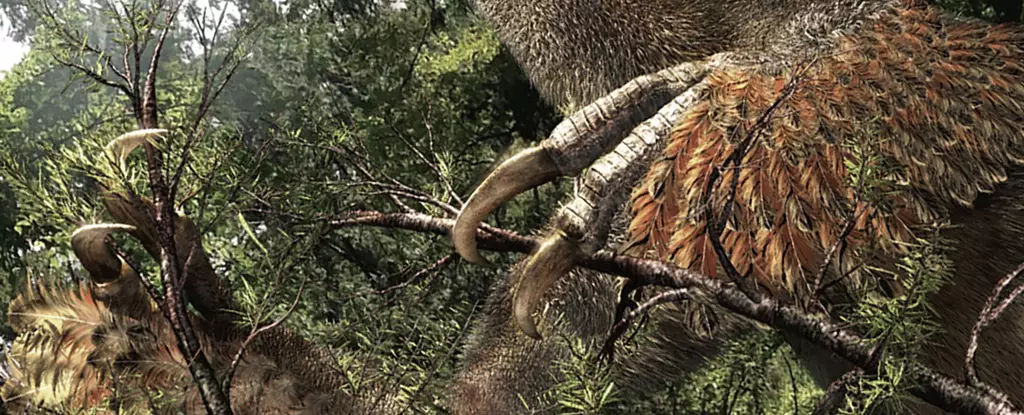The astonishing discovery of Duonychus tsogtbaatari, a feathered bipedal dinosaur sporting just two incredibly long fingers, has ignited a fervent debate within the paleontological community. This find, unearthed in the arid expanses of southeastern Mongolia’s Gobi Desert, presents an opportunity to reconsider what we thought we knew about the evolution of theropod hands, and by extension, the ecological dynamics of these prehistoric creatures.
Unprecedented Morphology: The Two-Fingered Wonder
At the core of the intrigue surrounding Duonychus is its unique anatomical structure—specifically, its two elongated fingers each armed with massive claw-like talons. Unlike its therizinosaurs relatives, which are commonly known for their three-fingered appendages, Duonychus pushes the boundaries of evolutionary expectations. The very fact that it possesses only two fingers raises fundamental questions about the adaptive significance behind this morphology. Why did this dinosaur forgo a third digit that seems to provide functional versatility?
The researchers hypothesize that the absence of the third finger may correlate with its feeding behaviors, suggesting that the remarkable curvature and agility of these claws enabled a specialized grasping strategy for vegetation. This interpretation evokes fascinating parallels to modern animals, such as sloths, that utilize similar adaptations to thrive in specific ecological niches. Duonychus, embracing two fingers in an evolutionary gamble, challenges the traditional understanding of finger functionality in theropods.
The Fossil That Shifts Paradigms
Discovered amidst the fossil-rich Bayanshiree Formation, this specimen allows researchers glimpses into a bygone era, dating back approximately 90 to 95 million years. The incredible preservation of the claws, complete with keratin sheaths and underlying bone structures, makes Duonychus tsogtbaatari remarkable not only for its unique fingers but also for its contribution to the fossil record. This fossil offers an unparalleled opportunity to scrutinize characteristics that typically do not survive the fossilization process, providing valuable insight into the physical traits of dinosaur anatomy.
Moreover, the fossils’ preservation challenges existing narratives regarding the decay of organic materials such as keratin. Paleontologists have often relied solely on bone structure to theorize animal behaviors and adaptations. Duonychus’s well-preserved claws could reevaluate long-held assumptions about soft tissue preservation, injecting a fresh perspective into methodologies employed in paleontological research and interpretation.
Ecological Implications and Evolutionary Consequences
Duonychus tsogtbaatari is not merely another dinosaur with an odd quirk; its discovery serves as a pivotal moment in the broader ecological understanding of theropods. The question of whether its hand structure influenced feeding ecology cannot be ignored. The specialized claws of Duonychus may have enabled it to occupy a unique ecological niche, catering to a diet that required adaptable foraging methods. Herein lies a crucial point: the evolutionary narrative is not merely a tale of survival but also of adaptation, innovation, and inter-species competition.
When we reevaluate the implications of Duonychus’s anatomical peculiarities, we must also consider broader ecological dynamics. How might these adaptations influence interactions with other organisms within their ecosystem? The multifunctionality of such claws raises further questions on territorial behavior, social interaction, and defense mechanisms within theropods and their contemporaries. It invites researchers to explore a variety of potential uses that transcend conventional feeding paradigms.
A Paradigm Shift in Paleontological Research?
The introduction of Duonychus tsogtbaatari into the paleontological lexicon is far more than a new name on the list of dinosaurs—it is a clarion call for reexamination. This discovery compels a reevaluation of what defines evolutionary success in terms of anatomical structure. As researchers ponder the evolutionary need for such radical adaptation, it positions Duonychus as a significant indicator of how environmental pressures can shape physical traits.
As we stand at the cusp of new revelations in evolutionary biology, Duonychus tsogtbaatari delivers an exhilarating challenge to established paradigms. Far from a footnote in the annals of dinosaur history, it represents the pioneering spirit of discovery, painting a vivid picture of a world that is perhaps more dynamic and adaptable than we once envisioned. The emergence of this two-fingered dinosaur emphasizes the complex interplay between evolution and ecology, forever altering our understanding of these magnificent creatures that once roamed the Earth.

Leave a Reply